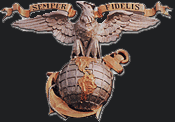| Posts: Managua, |
Author: By Robert F. Dorr and
Fred L. Borch
Special to the Times
February 27, 2006
|
Source: Submitted by Karen
Stanson
|
|
Congress
Special Reports
Frontline Photos
In 1926, Congress created a “Soldier’s Medal” to
recognize heroic acts of lifesaving and similar peacetime valor in the
Army. However, the Navy and Marine Corps lacked a similar award; a
letter of commendation was the only way to recognize non-combat heroism
by a Marine.
More than a decade later, in 1942, Congress passed legislation creating
a Navy and Marine Corps Medal. The law established a decoration that
could be awarded to “any person who, while serving in any
capacity with the United
States Navy or Marine Corps … distinguished himself or herself
by heroism not involving actual conflict with an enemy.”
Interestingly, the ribbon for the new Navy and Marine Corps Medal was
designed, approved and manufactured in late 1942, before the
medal’s design was even submitted for approval.
With World War II underway, the Navy recognized that the absence of an
actual medal would not preclude its awarding, since ;a leatherneck
could at least wear the ribbon. Its colors — blue, gold and
scarlet — were intended to reflect the colors of both the Navy
and the Marine Corps.
While Marines received and wore the new ribbon in January and February
1943, a design for the new medal was not officially approved until
March. And it did not go into production until summer 1943.
Submitted by Lt. Cmdr. McClelland Barclay, a naval reservist who was a
professional artist in civilian life, the approved design featured a
spread-winged eagle perched on a fouled anchor. Below the anchor was a
globe depicting the western hemisphere, and below that was the
inscription, “Heroism.”
While only about 450 Navy and Marine Corps Medals were awarded to
leathernecks during World War II, thousands have been awarded since.
Most decorations have gone to Marines for incidents in the U.S., but
there have also been awards for non-combat heroism on foreign soil.
For example, a small number of Navy and Marine Corps Medals went to
leathernecks for heroism during the violent and destructive earthquake
that struck Nicaragua in 1972. Cpl.
Norman Root was one of them. He received the decoration for
valor in rescuing a woman trapped in the wreckage of her apartment.
Root had arrived at the U.S. Embassy after midnight on Dec. 23. The
building was in ruins, and an adjacent apartment building had collapsed
as well. Root and several other Marines, at great risk to their own
lives, tunneled into the rubble and managed to dig the woman out.
Lance Cpl. Sean Gibson received the decoration for rescuing Marines
during cold-weather training in Alaska in 1989. Gibson risked his life
in temperatures reaching minus 70 degrees Fahrenheit to evacuate
seriously injured Marines.
Today, the Navy and Marine Corps Medal remains a rare award. It’s
the highest award for non-combat valor a Marine can receive.
Robert F. Dorr, an Air Force veteran, can be reached at robert.f.dorr@cox.net.
Fred L. Borch retired from the Army after 25 years.
He can be reached at borchfj@aol.com.
|
|





